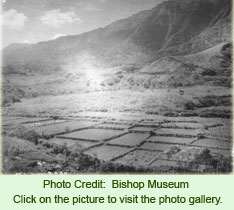
Hawaiian civilization reached new levels of excellence hundreds of years before Captain Cook’s arrival in the Hawaiian Islands when it established and mastered kalo cultivation. It has been noted that irrigated pond fields or lo‘i at one time produced 10 to 15 times more kalo (taro) than unirrigated kalo farms (Kelly 1989). In 1792, Captain George Vancouver visited O‘ahu, specifically the Waikīkī-Mānoa area. He took notice of the kalo cultivation that occupied much of the space in the Waikīkī area. One comment he made about kalo is that they "were in a very high state of cultivation” (qtd. in Kelly 1989). It is also noted that kalo is cultivated in other areas of the world such as, other islands in Polynesia, Indonesia, Melanesia, and southern Asia. However, kalo was not cultivated “as intensively or as skillfully as it was in the Hawaiian Islands" (Handy and Handy, 79).
For hundreds of years prior to western contact Hawaiians have lived in a pono (balanced) state with the environment. They did not over use nature’s resources. Instead, they took what nature has provided and created ways in which preserved the limited resources that an island has and at the same time devised ways so that they could be self sustaining. Lo’i and kalo cultivation is one prime example of how Hawaiians sustained themselves and flourished as a civilization. Living in a balanced state with the environment meant that the people took good care of the ‘āina which they lived and did not deplete its natural resources. In turn, the ‘āina was able to provide the people with enough food to comfortably sustain them for generations.
 |
